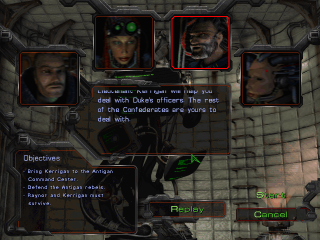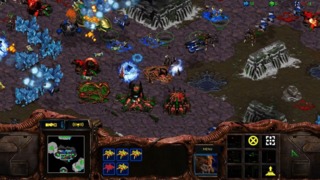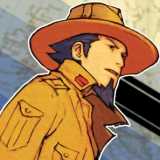Gaming Memories: StarCraft
By majormitch 7 Comments
Welcome to “Gaming Memories,” a blog series where I reminisce about my favorite video games. I will slowly but surely get to every game on the list, and speak to why each holds a special place in my heart. That not only means I’ll talk about why I think each is a great game that speaks to my tastes, but also where and how it affected me in a larger context. I hope you enjoy, and thanks for reading.
In the summer of 1999, my brother and I went to a week-long programming camp. Every day we had a couple breaks where we could chill out for a bit; get some snacks, go outside, or the most popular pick, play computer games. And there was one game in particular that immediately drew a crowd. My brother and I looked over the shoulders of a group of kids gathered around some computers, screaming with excitement. What we saw on their screens was like nothing I had ever seen before. Large, majestic spaceships battled for control of the airways, hardened soldiers and primal aliens spilled blood below, and large, diverse armies composed of imaginative and just plain wild stuff weaved their way around a large, complex map. My mind raced with possibilities, and thirty minutes later I was shooting zerglings with own marines. The rest, as they say, is history.

StarCraft was a revelation in multiple ways. First, my exposure to strategy games (and PC games in general) was limited at the time, so it was still a fresh genre to me. Second, unlike the few strategy games I had played at that point, StarCraft had three distinct factions with completely different units; it’s hard to fully convey how cool that was. Third, its campaign was an awe-inspiring and epic sci-fi tale that saw you control each of those three factions equally. It was an ambitious game with a scope I wasn’t used to, and that sprawling campaign was precisely what got me on board. To this day, it (combined with its expansion Brood War) remains one of my favorite campaigns in gaming. It stood out for its setting, characters, and writing, all of which were (and in some ways still are) well above your average video game fare. I remember all the big story beats, the characters and their motivations, the betrayals and big political shifts. Things happened in this campaign in a way they didn’t in most games of the era. And by seeing the story through the eyes of each faction, you got a sense that there were no true “good” or “bad” characters. It’s one of the first video game stories I encountered that presented a large ensemble cast in predominantly gray light. That was a clear inflection point in how I viewed the storytelling potential of the medium.
But it wasn’t just the narrative that I loved about StarCraft’s campaign. It looked and sounded great for its time, the map and scenario designs were dynamic and engaging, and most importantly, its fundamental mechanics were rock solid: gathering resources to research technologies and build up large armies felt right. In some ways, compared to other strategy games, StarCraft was a simple one with relatively few pieces. You only had two resources to worry about, and the number of technologies and units per faction was not all that large. But each of those technologies and units had a clear, defined function, and you needed different ones for different goals. These were not linear upgrades that saw early units and technologies become obsolete by the end of a long game. StarCraft had no replaceable units, which meant those starting marines and zealots were very much still viable at the end of a long game. In this way, StarCraft gained a lot of depth out of surprisingly few pieces. Late game armies could look wildly different in their compositions, and that led to all sorts of fascinating strategic options. Then you toss in the fact that all three playable factions had distinct technologies and units, and the possibilities grew exponentially. In this way, StarCraft embodied that “easy to learn, hard to master” dynamic extremely well. The limited resources, technologies, and units made it easy to understand for a newcomer, but the strategic depth created an extremely high ceiling for veterans. It’s a beautiful game.

If it was the campaign that wowed me and pulled me in initially, it was StarCraft’s other features that kept me hooked for the long haul. First, StarCraft remains perhaps the only game to date whose creation tools I got heavily invested in. The scripting options allowed you to create dynamic, story-driven missions, and I spent dozens of hours creating my own custom campaigns. But more long-lasting was StarCraft’s famed multiplayer. I was too young to play competitive games on the internet in the late 1990s, but even just playing LAN games with my brother against the AI was a lot of fun. For as much as I loved engaging with the strategy of StarCraft in the campaign, its depth became infinitely more apparent in a multiplayer setting, especially against other human competition. I did get to experience this years later in college, and trade lurker ambushes and carrier assaults with skilled and unpredictable competitors. It held up, and StarCraft stands tall among my fondest multiplayer experiences. Competition was where the game’s smart design shone brightest, and I have countless wonderful memories battling it out with friends.
StarCraft remains one of the most awe-inspiring games I’ve played. It was one of the first strategy games I played, one of the first sci-fi games I played, one of the first video game narratives I loved, and one of the first multiplayer games I got into. It’s a game that sparked my imagination through its artistic and aesthetic design, and captivated my inner strategist through its smart and balanced game design. I get a little wistful just thinking about it and all the little moments that come with it. It’s hard to fully express how formative StarCraft was, how much joy I derived from playing it, and how much it affected my view of the medium. I can’t imagine life without StarCraft, and I’m so happy I don’t have to.
